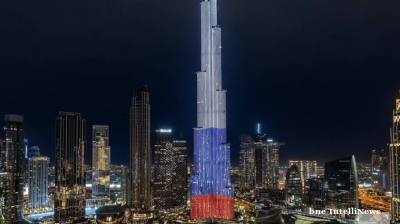The destruction of the Nord Stream pipelines in autumn 2022 marked an explosive end to a chapter in Russia-European energy ties. Almost two years on, we look at the many twists and turns in the Nord Stream saga, from Germany’s move to suspend Nord Stream 2, Russia’s cuts to gas flow at Nord Stream 1, the explosions that burst the pipelines and the many media reports that have since emerged pointing to who may have been responsible.
Russia starts cutting the flow
February 22, 2022: German Chancellor Olaf Scholz suspends the certification of Nord Stream 2, which had been completed in September of the previous year but had not yet been put into operation. The decision was taken in response to Russia’s recognition of the self-proclaimed republics of Luhansk and Donetsk in east Ukraine and movement of troops into the breakaway regions on the previous day.
February 23, 2022: the US imposes sanctions on the Switzerland-based Nord Stream 2 operating company, owned entirely by Russia’s Gazprom, building on previous measures against the project.
February 24, 2022: Russia launches its full-scale invasion of Ukraine.
March 1, 2022: the Nord Stream 2 operating company files for bankruptcy and lays off all its employees.
March 8, 2022: Responding to calls from member states to break off energy ties with Russia, the European Commission on March 8 unveiled its RePowerEU plan, which was eventually finalised just over two months later. In its final form, RepowerEU called for the rapid increase in LNG and other non-Russian gas imports and reductions in demand, with the aim of cutting Russian gas consumption by two-thirds by the end of 2022. With the rapid deployment of renewables and other low-carbon technologies, the goal was to eliminate Russian imports completely by 2027. In the end, due to the Kremlin’s own actions, Russian imports were cut far more quickly than Brussels had envisaged.
March 31, 2022: The Kremlin issues a decree that was commonly oversimplified in the media as a demand that “unfriendly countries” must pay for their gas supplies in rubles. The order in fact stated that buyers must set up accounts at Gazprombank, and there, the foreign currencies they pay would be transferred into rubles by the bank. The move is largely aimed at shielding Gazprombank from Western sanctions. Nevertheless, some European buyers still refuse to comply.
April 27, 2022: Gazprom cuts off gas supply to Poland and Bulgaria over their refusal to comply with the March 31 decree. Other European buyers lose their supply over the subsequent months, including in Denmark, France, Finland, Germany, Italy and the Netherlands. But the majority choose to comply.
This marks the start of the next stage in the severing of gas trade between Russia and Europe.
June 14, 2022: Gazprom declared on June 14 last year that it was cutting gas flow via the Nord Stream 1 pipeline by 40%, blaming Siemens’ failure to return a turbine on time that had been sent off for repair, as well as other technical difficulties at the Portovaya compressor station as a result of Western sanctions. The following day it restricted flow to only 40% of capacity, after switching off another turbine, causing supply shortages across Europe.
Various European leaders accused Gazprom of weaponising gas supply, particularly as Canada, where the turbine previously mentioned was repaired, had shipped it to Germany for onward delivery to Russia. Russia refused to accept the turbine, claiming it lacked sufficient documentation and guarantees.
July 25, 2022: The Russian exporter cut flow again, to only 20% of capacity, stating that it had had to shut down another turbine servicing the pipeline.
August 31, 2022: Russia shuts down the Nord Stream 1 completely, stating the need for three days of maintenance. Gazprom’s announcement of the downtime 10 days earlier saw European gas prices climb to an all-time record of close to $4,000 per 1,000 cubic metres.
September 2, 2022: Russia delays Nord Stream 1’s restart, claiming it has discovered a fault during maintenance work. Gazprom says it can no longer provide a timeframe for resuming operations. The pipeline never flows gas again.
Explosions rock the Baltic Sea
September 26, 2022: A series of underwater explosions in the Baltic Sea severely damage three out of four pipelines of Nord Stream 1 and 2. The explosions cause gas leaks and render the pipelines inoperable. The damage occurs near the Danish island of Bornholm, within international waters but also inside the economic zones of Denmark and Sweden.
In the days following, even though only initial details of the incidents have emerged, a consensus builds across Europe that they were acts of sabotage. Various individual European politicians and commentators say Russia was behind the attack, but representatives of Western governments stop short of any official accusations. Russia, on the other hand, accuses the US and its allies of blowing up the pipelines. Putin will continue blaming the “Anglo-Saxons” during the coming years, without providing any evidence.
October 2, 2022: Sweden launched an investigation into the explosions. Denmark follows suit on October 6, and Germany on October 13.
November 18, 2022: Sweden concluded its initial investigation, reporting that the explosions were the result of “gross sabotage,” having confirmed the presence of explosive residues at the site.
November 23, 2022: Denmark also completes its preliminary probe, confirming that the leaks were caused by “powerful explosions.”
Media begins pointing fingers
February 13, 2023: Veteran US journalist Seymour Hersh publishes an investigative article claiming that the US Navy, at the behest of US President Joe Biden, was responsible for blowing up the pipelines. Citing unidentified sources, he asserts that planning for the attack started in December 2021. In June 2022, he said that under the cover of a military training exercise, the US Navy placed explosives on the pipelines, which were then remotely detonated on September 26. The operation was ordered by Biden and planned by Secretary of State for Political Affairs, Victoria Nuland, and National Security Advisor Jake Sullivan, he asserted.
The White House responded by describing the allegations as “false and complete fiction,” and the CIA likewise said: “This claim is completely and utterly false.”
The Kremlin leaps on Hersh’s conclusions as vindication of its own claims that Washington was behind the sabotage of the pipelines.
March 7, 2023: The New York Times reports that new intelligence reviewed by US officials indicated that a pro-Ukrainian group was responsible for the attack, but that there was no evidence that either Ukrainian President Volodymyr Zelenskiy or top figures in his administration were involved. The newspaper adds that there is no evidence that the perpetrators were acting on the order of any Ukrainian government official.
March 10, 2023: Germany’s Der Spiegel reports that a team of divers using a 15-metre chartered yacht called the Andromeda sabotaged the pipelines. The report stops short of assigning responsibility for the attacks to any group, but asserts that one of the six-person crew had used a forged Bulgarian passport. It goes on to quote a harbour master on the German island of Ruegen, where the yacht stayed at one point, as saying that the group that had chartered Andromeda were dressed as normal sailors and spoke in a language that “sounded Polish or Czech to him.”
March 27, 2023: The UN Security Council rejects a request from Russia for an independent inquiry into the Nord Stream blasts, as a result of 12 council members abstaining in a vote. The Kremlin says it will keep demanding an international investigation.
June 6, 2023: The Washington Post reports that the Biden administration was made aware of a Ukrainian plot to blow up the Nord Stream pipelines three months before the explosions took place. According to the newspaper, the CIA received a European intelligence service report that Ukraine’s military was plotting the attack with the use of a small team of divers who were reporting directly to the then commander in chief of the country’s armed forces, General Valerii Zaluzhny.
August 26, 2023: Der Spiegel reports that evidence strongly suggests a link between the explosions and Ukrainian nationalists, citing leaked results obtained from Germany’s investigation, verified as much as possible with the newspaper’s own probe conducted together with German public broadcaster ZDF.
February 7, 2024: Sweden ends its probe, stating that it does not have the jurisdiction to pursue the case further. It hands over its findings to German investigators.
February 26, 2024: Denmark closes its investigation into the Nord Stream case, concluding that the pipelines had been “sabotaged,” but says there is no basis for pursuing a criminal case.
The first arrest warrant
August 14, 2024: Germany’s Sueddeutsche Zeitung and Die Zeit newspapers and the ARD public broadcaster report that Germany has issued a European arrest warrant for a Ukrainian diving instructor, named as Volodymyr Z, for his connection with the sabotage of the Nord Stream pipelines. According to the reports, investigators believe Volodymyr Z was a member of a team that planted explosive devices on the pipelines. German law does not allow publication of the suspect’s surname.
Poland’s prosecutor’s office confirms on the same day it had received an arrest warrant for a Ukrainian man named Volodymyr Z in June. Germany’s probe identified another man and a woman that were also Ukrainian diving instructors, according to the media reports, but no arrest warrants have been issued for them yet.
The Wall Street Journal also reports that a group of senior Ukrainian military officers and businessmen organised the operation to explode the Nord Stream pipelines, which cost a mere $300,000 and involved renting the Andromeda yacht with a six-member crew.
According to the journal, Ukrainian President Volodymyr Zelenskiy initially approved the plan but ordered it to be terminated when the CIA found out about it and asked for it to be called off. Zelenskiy’s then commander in chief, Valeriy Zaluzhniy, nevertheless went ahead.
August 15, 2024: A spokesperson for Zelenskiy denies Ukraine’s involvement in the explosions, once more accusing Russia of being the perpetrator. “Such an act can only be carried out with extensive technical and financial resources … and who possessed all this at the time of the bombing? Only Russia,” the spokesperson told Reuters. Other Ukrainian agencies also deny involvement and deny Zelenskiy approving of such a plan.
August 19, 2024: Despite these recent reports, Russian Foreign Minister Sergey Lavrov reiterates Moscow’s position that the US ordered the attacks on the pipelines.
“It is clear that to carry out such a terrorist attack, there was a command from the very top, as they say. The very top for the West is, of course, Washington,” Lavrov told Russia’s Izvestia newspaper.
This article is from bne IntelliNews’ sister publication NewsBase that covers global energy issues. Sign up for a two-week trial here.
Features
KSE: Ukraine is facing a $53bn budget shortfall, but economy is stable for now
Ukraine is in urgent need of additional financing from partners as the continuation of the war drives up defence spending and reconstruction needs, jeopardizes budget financing, weighs on the balance of payments, and slows economic growth.

PANNIER: Ruling family’s ‘palace in the sky’ cruel sight for Turkmenistan’s poor souls down below
Photos posted of renovated Boeing by US makeover manager offer further insight into "ultra-luxurious" world enjoyed by Berdimuhamedovs.

Russia tax service targets Russian accounts in UAE
The Russian Federal Tax Service (FTS) has ramped up its scrutiny of Russian nationals holding accounts in the United Arab Emirates, following the effective implementation of automatic tax information exchange between the two countries.

INTERVIEW: Can Albania’s tourism miracle last?
As social media brings in the crowds, the head of the Albanian Tour Operators Association tells bne IntelliNews Albania should turn away from mass-market tourism and focus on higher-value offerings.


